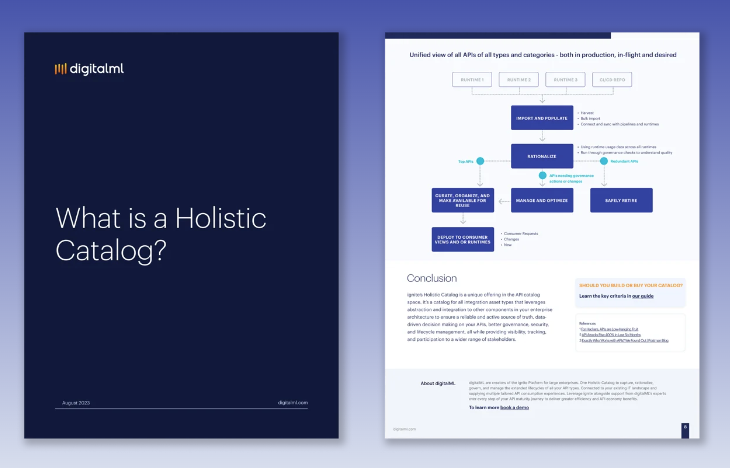13 Modern API Metrics Every Enterprise Should Be Tracking: Accelerating API Program Maturity
Enterprises are continuing to embrace the critical role of APIs in driving innovation, efficiency, and connectivity. As APIs are now central to business strategies, the importance of a sophisticated approach to API metrics and key performance indicator (KPI) tracking across the entire API portfolio is growing.
Moving beyond basic and siloed analytics, enterprises are now delving into advanced reporting to effectively track and enhance their API maturity journey.
Here at digitalML, we’ve been collaborating closely with our large enterprise clients to identify the modern API metrics that are most pivotal to their success. Through this partnership, we’ve compiled a list of 13 metrics you’ll find invaluable for optimizing and evolving your API program.
Catalog Metrics: The Foundation of API Reporting
The first set of metrics are focused around understanding the makeup of your entire API portfolio, giving you an accurate view into what you have and where it’s running and being consumed.
1. Coverage against Business Capability Models
Tracking your API coverage against a taxonomy evaluates how well your APIs are supporting your key business functions, providing insight into priority areas for expansion or improvement. Many enterprises will also want to measure coverage at more granular levels too, such as regional or Line of Business (LoB).
2. API Calls by Runtime
Tracking the volume of API calls across different runtime environments helps identify usage patterns and possible bottlenecks, and potential cost savings as a result.
3. APIs by Design Type
Understanding the distribution of internal vs external vs partner API design types provides insight into the composition of your API portfolio, and where your functionality is coming from.
4. Deployed APIs
The total number of deployed APIs gives a snapshot of your current API production landscape, highlighting growth and scaling efforts. This API metric also provides insight into the lifecycle states of your catalog contents.
5. APIs Published to All Consumer Portals
Monitoring APIs available on internal, external, and partner consumer portals is crucial for assessing what portion of your catalog has been made available for adoption and reuse by your API consumers.

Maturity Progression Metrics: Tracking API Portfolio Evolution
This set of API metrics helps you understand and prioritize areas for API program maturity.
6. APIs by Interface Type
Differentiating APIs by their interface types (e.g., REST, SOAP, Event, GraphQL) can help in evaluating technology adoption and evolution within your organization, especially when it comes to modernizing legacy IT implementations. You can also gain insight into your enterprise’s architectural choices and consumer preferences.
7. Curation and API Product Bundle Candidates
Identifying APIs that are already receiving high traffic volumes helps you evaluate which might be suitable for API curation (surrounding with consumer-centric metadata) and further reuse. Curated APIs improve developer experience and API usability.
Spotting API Product Bundle Candidates is another way to support reuse. APIs that are used regularly in common patterns might be suitable to be grouped together into a Product Bundle and offered up to application developers to work from.
8. Potential Zombie APIs
API security is a top priority for enterprises. Highlighting underused or obsolete APIs can aid in cleanup efforts, ensuring resources are allocated efficiently. And tracking a reduction in the total number is a good metric of API security maturity.
9. Duplicate API Reduction
Reducing API duplication over time is a good indication of maturity progression as there are associated cost and maintenance overhead savings when (often many) very similar APIs are consolidated into one, reusable across LoBs, regions, and teams.
Governance & Security Metrics: Ensuring Compliance and Safety
API governance and security is paramount to enable an effective and mature API program. Here’s some metrics to understand and use governance across the entire portfolio.
10. APIs Passing/Failing Governance in Your Catalog
This metric is essential for maintaining high standards of quality and ensuring regulatory compliance across all APIs captured in the catalog. Tracking this metric ensures you’re tracking tour overall API governance maturity.
11. APIs Passing/Failing Governance in Consumer Portals:
Similar to catalog governance, this metric focuses on consumer-facing APIs, ensuring they meet regulatory and company standards.
12. Un-curated APIs Passing Governance
This metric helps identify further candidates for API reuse from the catalog; those that have been aligned to your enterprise standards during the API development phase but not yet marked as curated by product managers in the catalog.
13. Runtime Reconciliation – APIs Not in the Catalog
Identifying deployed APIs not yet captured in your catalog is crucial for security, governance, and preventing shadow IT practices.
Why These API Metrics Matter
These 13 metrics provide a comprehensive view of your enterprise’s API landscape as it evolves over time, offering insights into business coverage, usage patterns, technological evolution, and compliance status. By tracking these metrics, you can:
- Enhance enterprise decision-making with data-driven insights.
- Accelerate API maturity by identifying areas for improvement.
- Ensure API ecosystems are secure, compliant, and aligned with business goals.
Conclusion
For enterprises focusing on accelerating their API maturity journeys, it’s time to move beyond basic and siloed analytics, to more advanced, comprehensive metrics that give insight into the entire API landscape.
At digitalML, we’re committed to helping our customers navigate and excel at this journey. That’s why we’ve built in next-gen reporting and logic to our ignite Platform help you analyze and action your API portfolio from one unified view. Book a demo with our API experts today to see ignite’s reporting in action.
Differentiate Your Digital Enterprise Now
Learn how it can help your enterprise accelerate digital transformation




